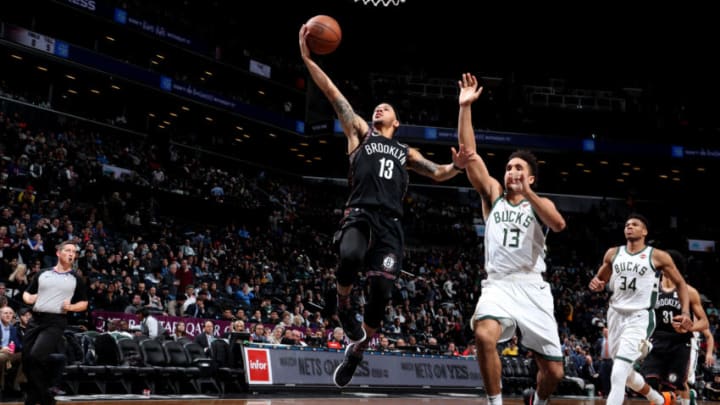
2. Thanks to versatile bigs, Shabazz Napier’s weaknesses can be minimized in Minnesota
When I turned on the tape, it was evident to me that Napier’s struggles were undoubtedly a result of two things: his height and his big men teammates.
The 6-foot-1 point guard struggled in the pick and roll, mostly because his drew hard hedges and double teams that forced him to pass the ball or take contested jumpers late in the shot clock. This was the result of playing with two rim-running bigs whose defenders wanted to prevent lobs by crowding Napier and disrupting his passing lanes.
On the infrequent occasion when Napier drew switches from larger defenders, he was often able to effectively get around them and make the right reads from there, resulting in easy buckets.
Nets bigs Jarrett Allen and Ed Davis provided very little versatility in terms of their abilities to stretch the floor, which kept much taller defenders in the lane to contest and block Napier’s shots on his takes to the rim.
This is a perfect example. Ed Davis camps on the opposite block, which allows his defender to stand right underneath the rim and come over and block the shot.
During his tenure the Nets, Napier often tried to do too much and get too acrobatic in the air as a result of frequently getting blocked in the lane.
In this clip, instead of trusting himself and finishing with his right hand (and likely drawing a foul from Whiteside), he throws up a wild shot with his left hand.
When taking a look at the numbers, two other areas that Napier struggled last season were in the pick and roll as a ball handler and in transition.
Shabazz’s 0.84 points per possession in the pick-and-roll ranked in 55th percentile, which was disappointing considering it was the most frequently ran action when he was on the floor. Brooklyn ran a pick-and-roll-heavy offense and Napier didn’t show any major signs of improvement throughout the season.
His effective field goal percentage was a poor 41.2 percent and he turned it over 14.3 percent of the time in these actions.
The hope is that having two versatile big men, KAT and Vonleh, that can shoot the three and play inside will open more options up for Napier in the pick and roll, but we’ll have to see how that plays out.
In transition opportunities in which he touched the ball, Napier registered 1.08 points per possession, which ranked him in the 42nd percentile in the 2018-19 campaign, per NBA.com.
Napier often opted for shooting threes on the break, which helped him shoot a strong effective field goal percentage of 62.3 percent.
Despite his tendency to fill to the corners, Napier also wasn’t afraid to go at defenders when he led the break.
His ability to adjust in mid-air and finish around defenders translates to transition on film, but doesn’t impact analytics much because of the irregularity with which he attempts layups on the break.
Despite his shortcomings last season, the Minnesota front-court should give Napier more options out of the pick and roll than ever before. As a result, he’ll have a much easier time creating for himself and his teammates because he won’t have to deal with as much pressure in his face.
Because his weaknesses can be remedied with smart coaching in Minnesota, you can expect Shabazz Napier to play north of 20 minutes per game and find success playing on and off the ball next season.
Let’s get into what his role might look like.
